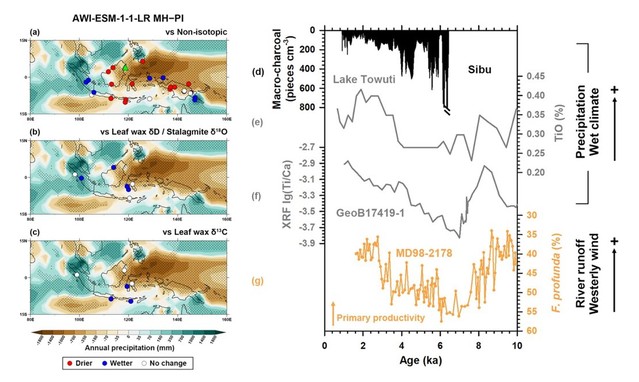Xinquan Zhoua, Xiaobo Jina, Xiaoxu Shib, Chuanlian Liua, *
aState Key Laboratory of Marine Geology, Tongji University, Shanghai, China
bSouthern Marine Science and Engineering Guangdong Laboratory (Zhuhai), Zhuhai, China
*Corresponding author: liucl@tongji.edu.cn
Abstract: This study investigates how convection over the Indo-Pacific warm pool (IPWP) differed during the mid-Holocene compared to the preindustrial period. The research employs modeling data from the Paleoclimate Modelling Intercomparison Project phases 3 and 4 combined with published hydroclimate records from the Maritime Continent and a new primary productivity reconstruction in the western Celebes Sea. While there is large variability amongst models in terms of simulating precipitation changes, the model AWI-ESM-1-1-LR has the highest agreement with proxy data. This model indicates a dipole pattern consisting of strengthened convection over the eastern equatorial Indian Ocean and Sumatra and weakened convection over the western equatorial Pacific and Borneo-Sulawesi-New Guinea. The reduced convection over the latter region is supported by the primary productivity record illustrating lower precipitation over Borneo and a deepened nutricline in the western Celebes Sea driven by anomalous equatorial easterly winds. This dipole pattern demonstrates an anomalous trans-ocean zonal circulation cell that links the western equatorial Pacific and equatorial Indian Oceans. This cell emerging in summer and peaking in autumn, is proposed to arise from a trans-ocean zonal imbalance of equatorial precipitation change induced by altered summer insolation, and higher equatorial insolation in autumn. The increased precipitation in South Asia during the mid-Holocene is partially attributed to moisture transported from the western equatorial Pacific associated with this anomalous zonal cell. Thus, the dipole pattern of altered IPWP convection is tightly linked to dynamic precipitation changes and can influence regions outside the IPWP.
Full Article: https://www.sciencedirect.com/science/article/pii/S027737912300447X


